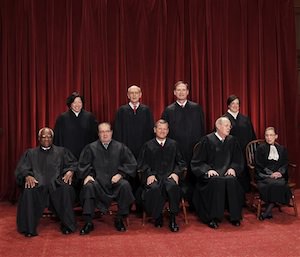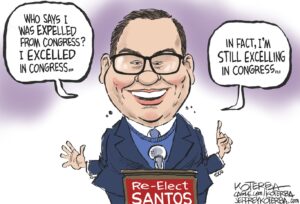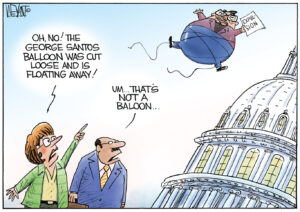Gutting the Voting Rights Act
No matter how you parse it, the Supreme Court’s decision Tuesday in Shelby County v Holder is a constitutional train wreck of historic proportions But unlike most such disasters, this is one we saw coming No matter how you parse it, the Supreme Court’s decision Tuesday in Shelby County v.
No matter how you parse it, the Supreme Court’s decision Tuesday in Shelby County v. Holder, which gutted the Voting Rights Act, is a constitutional train wreck of historic proportions. But unlike most such disasters, this is one we saw coming.
In 2009, in an otherwise obscure case involving a Texas utility district with an elected board of directors (Northwest Austin Municipal Utility District No. 1 v. Holder) that was brought to the court by the same group of right-wing activists that engineered the Shelby County case, Chief Justice John Roberts’ majority opinion questioned the continued validity of Section 5 of the Voting Rights Act. That section requires states and localities with a legacy of electoral discrimination to obtain “preclearance” from the Justice Department or the courts before implementing new voting laws and procedures. Currently, nine states — mostly in the Deep South, along with a smattering of counties and cities elsewhere — are covered by Section 5.
In Tuesday’s fractious 5-4 Shelby County opinion, also authored by Roberts, the court left Section 5 standing but declared Section 4 of the act unconstitutional, which sets forth the formula for determining which jurisdictions across the country are subject to preclearance requirements. As Justice Ruth Bader Ginsburg reasoned in an impassioned dissent joined by the court’s liberals, without the Section 4 formula, Section 5, along with all its vital safeguards, is effectively “immobilized.”
At the heart of the Roberts opinion is the view that racism in America is a thing of the past. When the Voting Rights Act was enacted in 1965, Roberts wrote, “the States could be divided into two groups: those with a recent history of voting tests and low voter registration and turnout, and those without those characteristics. Congress based its coverage formula on that distinction. Today the nation is no longer divided along those lines, yet the Voting Rights Act continues to treat it as if it were.”
Because black voter turnout and registration in the South have increased dramatically since that time, the Section 4 formula was, Roberts continued, out of date and thus an unconstitutional “departure from the fundamental principle of equal sovereignty” under the nation’s federal system. Congress, of course, would be free to update the Section 4 formula, but as the Northwest Austin case had foreshadowed, the court would no longer wait for the nation’s legislative body to act.
The Shelby County majority opinion is breathtaking, not only for the scope of its judicial activism — Congress had reauthorized the Voting Rights Act for an additional 25 years in 2006, with the Senate expressing its endorsement by a vote of 98 to 0 — but for its distortion both of the country’s racist past and its racist present.
Not very long ago, by historical standards, slavery was lawful in America, as recognized by the Constitution’s infamous “three-fifths” clause (Article 1, section 2, paragraph 3), which provided:
Representatives and direct Taxes shall be apportioned among the several States which may be included within this Union, according to their respective Numbers, which shall be determined by adding to the whole Number of free Persons, including those bound to Service for a Term of Years, and excluding Indians, three fifths of all other Persons (emphasis added).
Despite ratification of the 13th Amendment abolishing slavery in 1865 and passage in 1870 of the 15th Amendment prohibiting states from denying citizens the right to vote on the basis of race, voting discrimination remained unchecked under the “separate but equal” doctrine throughout the South. The catalog of suppression techniques included the poll tax, first enacted in Georgia in 1871 and, by 1904, adopted throughout the former Confederacy; the literacy test, first imposed by South Carolina in 1882; whites-only primaries; and state laws and local ordinances that made it difficult for black voters to establish residency and register. And when all else failed, the Old South was never above outright intimidation of black voters and African-Americans seeking elective office.
Today, in large part because of the Voting Rights Act, such practices have been eradicated. But as anyone outside the Supreme Court’s historical time warp well knows, new suppression techniques have taken their place, including costly voter ID requirements, district gerrymandering, sweeping curbs placed on early voting and restraints erected against streamlined voter registration.
These new techniques have taken root not only throughout the South, but in other parts of the country as well, particularly in states under Republican control. According to the New York City-based Brennan Center for Justice, since 2011, 19 states have enacted voting laws or adopted executive actions aimed at restricting turnout. In the 2012 election cycle alone, the Justice Department relied on Section 5 of the Voting Rights Act to stop such laws from taking effect in Texas, South Carolina and several key Florida counties.
Without the Section 4 formula that gives life to Section 5, opponents of voter suppression will be left only with Section 2 of the act — its general anti-discrimination provision — to mount future legal challenges. But unlike Section 5, Section 2 places the legal burden of proof in court on the victimized voters who will have to bring such challenges and who will be saddled with the enormous litigation expenses those challenges would entail.
Perhaps Roberts actually believes the fantasies that such burdens are easily surmounted or that our dysfunctional Congress will suddenly experience a pang of conscience and redraft Section 4 to the court’s approval. In the wake of the tribunal’s decision, Senate Majority Leader Harry Reid promised Tuesday a quick response from the upper chamber. Even if that happens, however, it remains extremely doubtful that House Republicans will take similar action.
In the meantime, it appears the court majority has finally accepted the view of Justice Antonin Scalia, who in the Shelby County oral argument in February articulated an ideology of racial resentment, blasting the Voting Rights Act as the “perpetuation of a racial entitlement” that Congress would never have the political courage to overturn.
The Roberts court has now gone where Congress has dared not. No matter how the justices rule on other issues during this or any other subsequent term, this court will be remembered for callously and decisively turning its back on the most basic principle of democracy — the right to vote.
Your support matters…Independent journalism is under threat and overshadowed by heavily funded mainstream media.
You can help level the playing field. Become a member.
Your tax-deductible contribution keeps us digging beneath the headlines to give you thought-provoking, investigative reporting and analysis that unearths what's really happening- without compromise.
Give today to support our courageous, independent journalists.









You need to be a supporter to comment.
There are currently no responses to this article.
Be the first to respond.